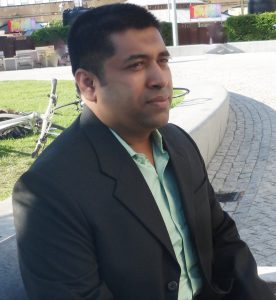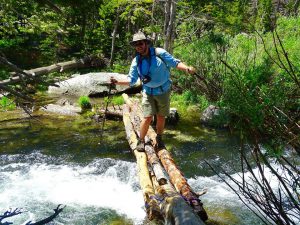
Research Interest
My research domain spans from field to basin scale hydrological modelling with a wide range of hydrological models (both numerical and conceptual). In particular, investigating wetlands’ hydrologic and hydraulic interactions with surrounding environments (e.g. rivers and aquifers) has been a preferable area to me over the last couple of years. Under my PhD work, I have developed a variant of Soil and Water Assessment Tool (SWAT) model to enhance SWAT’s capability in simulating riparian wetlands’ hydrology. My research also includes treatment (downscaling and bias correction) of raw Global Climate Model (GCM) generated data and assessing climate change effects on terrestrial water distribution. My current research is simulating groundwater recharge in an Amazonian experimental ranch where I am using the numerical HYDRUS model.
Education
PhD 2017: University College London (UCL), UK; Department of Geography (Wetland Hydrology Unit)
MS 2011: North Dakota State University, USA; Agricultural and Biosystems Engineering Dept.
MS 2006: Bangladesh Agricultural University, Bangladesh; Irrigation and Water Management Dept.
BS 2004: Bangladesh Agricultural University, Bangladesh; Faculty of Agricultural Engineering and Technology.
Selected Publications
Rahman, M. M., Thompson, J. R, and Flower, R. J. 2019. Hydrological impacts of climate change on river-wetland systems in the Upper Meghna River Basin (Bangladesh and India) and their implications for rice cultivation. Hydrological Sciences Journal. DOI: 10.1080/02626667.2019.1676427
Rahman, M. M., Thompson, J. R, and Flower, R. J. 2016. An enhanced SWAT wetland module to quantify hydraulic interactions between riparian depressional wetlands, rivers and aquifers. Environmental Modelling and Software, vol: 84, p: 263-289. doi.org/10.1016/j.envsoft.2016.07.003
Rahman, M. M., Z. Lin, X. Jia, D. D. Steele, and T. M. DeSutter. 2014. Impact of subsurface drainage on streamflows in the Red River of the North basin. Journal of Hydrology, vol: 511, p: 474-483. doi.org/10.1016/j.jhydrol.2014.01.070
]]> Research Interests
Research Interests
The health of the High Plains Aquifer is directly related to the extent and demands of the irrigated landscapes that exist within it. My research aims to further the understanding of this irrigation by generating high resolution GIS map products using remotely sensed imagery fused with environmental data.
CV
Posters, Papers, and Publications
]]>
Research Interests
Numerical simulation and uncertainty quantification of groundwater flow and solute transport
Water resources sustainability
Coupled climate, hydrologic and social-economic systems
Model-data fusion
Machine learning
Education
Ph.D. Civil Engineering, University of Illinois at Urbana-Champaign, Jun. 2012 – Aug. 2016
Thesis title: An efficient fully Bayesian approach to uncertainty quantification of groundwater models
M.S. Civil Engineering, University of Illinois at Urbana-Champaign, Aug. 2010 – May. 2012
Thesis title: Use of data-driven models to improve prediction of physically based groundwater models.
B.S. Geotechnical Engineering, Nanjing University, China, Sep. 2006 – Jun. 2010
Publications
Xu, A. J. Valocchi, M. Ye and F. Liang. Quantifying model structural error: efficient Bayesian calibration of a regional groundwater flow model with a data-driven error model and fast surrogates. Water Resources Research, submitted.
Xu and K. Guan, Temporally and spatially ranging response of rainfed corn yield to climate and extreme events in the U.S. Corn Belt, Global Change Biology, in preparation.
Xu, A. J. Valocchi, M. Ye, F. Liang and Y.F. Lin. Bayesian calibration of groundwater models with input data uncertainty. Water Resources Research, in revision.
Xu and A. J. Valocchi. A Bayesian approach to improved calibration and prediction of groundwater models with structural error. Water Resources Research, 51(11): 9290-9311, 2015.
Xu and A. J. Valocchi. Data-driven methods to improve baseflow prediction of a regional groundwater model. Computers & Geosciences, 85(B): 124-136, 2015.
Choi, J., E. Amir, T. Xu and A. J. Valocchi. Learning relational Kalman filtering. In Proc. 29th AAAI Conf. on Artificial Intelligence (AAAI-15), Austin, TX, Jan. 2015.
T. Xu, A. J. Valocchi, J. Choi, and E. Amir. Use of machine learning methods to reduce predictive error of groundwater models. Groundwater, 52(3): 448-460, 2014.
Complete CV
CV (Last Updated September 2016)
]]>
 Research Interest
Research Interest
My research interests involve examining shallow groundwater, surface hydrology and groundwater-surface water interactions through empirical observation and geochemical (isotopic) methods. My interest in this area stems from a desire to help our society better manage these natural resources and best prepare for the changes to these systems due to global climate change. My current research involves examining changes to groundwater and river systems in Michigan’s Lower Peninsula due to changes in snow melt timing and dynamics. Previous research involved the use of stable isotopes to better understand the relations of groundwater, surface water and precipitation at the headwaters of the White River in Manistee National Forest and quantifying groundwater discharge into the White River through the use of seepage meters.
Education
2016-Present: Ph.D. student in Environmental Geoscience, Michigan State University
2014-2016: MS in Geoscience, Western Michigan University
2009-2014: BS in Geology, University of Southern Indiana
Abstracts
Doss, P.K., Feldhaus, A, Ford, C., Stephens, M. and Chambers, T.B., 2014, Long-Term Monitoring of Water Resources with Undergraduate Student Collaborators: Geological Society of America Abstracts with Programs. Vol. 46, No. 6, p.527.
Ford, C. M. and Doss, P. K., 2013, Characterizing Groundwater Seepage In The Headwaters Of The White River, Manistee National Forest, Michigan: Geological Society of America Abstracts with Programs. Vol. 45, No. 7, p.201
Ford, C.M., Hampton, D.R., Doss, P.K., and Krishnamurthy, R.V., 2015, Characterizing Heterogeneous Discharge in the Headwaters of the White River, Manistee National Forest, Michigan: Abstract M-35 presented at the 2015 AGU Chapman Conference: The MADE Challenge for Groundwater Transport in Highly Heterogeneous Aquifers: Insights from 30 Years of Modeling and Characterization at the Field Scale and Promising Future Directions, Valencia, Spain, 5-8 October.
CV
Ford – Curriculum Vitae August 2016
]]>

Research Interests
My research interests include using sensing techniques to quantify near surface transport in order to serve a global society. Currently, I am modeling recharge in the Southern High Plains Aquifer in response to land use and climate change in order to better understand the future of food and water sustainability in this heavily irrigated area. Previously, I have quantified surface water-groundwater exchange using electrical resistivity tomography in order to better understand hyporheic transport as a design goal for stream restoration structures.
Education
2014-Present, PhD student in Environmental Geoscience, Michigan State University
2012-2014, MS in Geoscience, University of Iowa
2008-2012, BS in Geology, Environmental Science, Olivet Nazarene University
PRESENTATIONS
Smidt, SJ, JA Cullin, AS Ward, J Robinson, MA Zimmer, LK Lautz, TA Endreny. A comparison of hyporheic transport at a stream restoration structure and natural feature. Department of Engineering Research Open House, Iowa City, IA. 2014.
Smidt, SJ, AS Ward. Using electrical resistivity tomography to quantify hyporheic exchange. James F. Jakobsen Graduate Conference, Iowa City, IA. 2014.
Smidt, SJ, AS Ward. Electrical resistivity tomography as a hydrogeophysical tool for characterizing surface water-groundwater interactions. Annual Meeting of the Iowa Academy of Science, Fort Dodge, IA. 2014.
Smidt, SJ, AS Ward. Quantifying the controls of discharge and regional hydrogeologic gradients hyporheic exchange. American Geophysical Union Fall Meeting, San Francisco, CA. 2013.
Smidt, SJ, AS Ward. Quantifying the controls of discharge and regional hydrogeologic gradients hyporheic exchange. Geological Society of America Annual Meeting, Denver, CO. 2013.
Smidt, SJ, AS Ward, JA Cullin, J Robinson, TA Endreny, LK Lautz, MA Zimmer. Do stream restoration structures create hyporheic zones that are comparable to those at natural features? Society for Freshwater Science, Jacksonville, FL. 2013.
Smidt, SJ, AS Ward. Experimental design for quantifying the role of stream gradient and discharge on hyporheic exchange. James F. Jakobsen Graduate Conference. Iowa City, IA. 2013.
Ward, AS, J Robinson, TA Endreny, JA Cullin, SJ Smidt, LK Lautz, MA Zimmer. Do stream restoration structures create hyporheic zones that are comparable to those at natural features? American Geophysical Union, San Francisco, CA. 2012.
PUBLICATIONS
Smidt, SJ, JA Cullin, AS Ward, J Robinson, MA Zimmer, LK Lautz, TA Endreny. A comparison of hyporheic transport at a stream restoration structure and natural riffle feature. Groundwater. In Review.
CV
Download my complete CV
]]>
Environmental challenges are complex and require expertise from multiple disciplines. Consequently, there is growing interest in interdisciplinary environmental research that integrates natural and social science, an often arduous undertaking. We surveyed researchers interested and experienced in research at the human–environment interface to assess perspectives on interdisciplinary research. Integrative interdisciplinary research has eluded many of our respondents, whose efforts are better described as additive multidisciplinary research. The respondents identified many advantages and rewards of interdisciplinary research, including the creation of more-relevant knowledge. However, they also reported significant challenges and obstacles, including tension with departments (49%) or institutions (61%), communication difficulties, and differing disciplinary approaches, as well as institutional barriers (e.g., a lack of credit in promotion and tenure). Most (52%) believed that developing interdisciplinary breadth should begin as early as the undergraduate level. We apply our results to recommendations for successful interdisciplinary endeavors.
Article:
]]> Personal History
Personal History
Some say I was born with a rock in my hand. My first memories are of rocks. In fact, all of my memories involve rocks. When I was very young I was playing in a stream looking for rocks, I noticed that rocks in the stream were much smoother than rocks on the banks of the stream. I thought “That’s pretty neat”. At that moment I knew that I wanted to learn about rocks and water, forever. My only wish was that there was some field of study that incorporated both of those concepts.
Education
No Formal Education.
Nomadic skills acquired from years spent living with wild bears in the heart of the Siberian Forests.
Served as a test dummy for many governmental experiments in the early 2000’s.
]]>